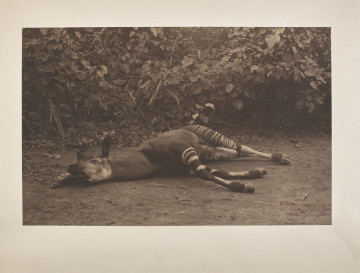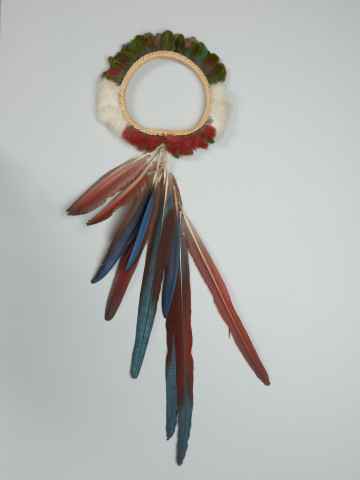
Okapi
1924
Castle Museum in Łańcut
Part of the collection: Crafts of the Amazon Indians
The presented necklace comes from the collection of Boris Malkin, a collector and researcher of Latin American cultures. In 1970 and 1971, he conducted field research in Santa Rosa de Sucumbios, a settlement of Kofán Indians located on the border of Ecuador and Colombia. The village consisted of only five houses and had 50 inhabitants, whom the researcher wrote letters to his wife as follows: They are fabulously picturesque. Both sexes wear coils of various beads around their necks, as well as various necklaces. (...) Both of them like to wear feathers in their noses, and once I saw a woman wearing... a colourful wing of a dragonfly! I haven't seen that anywhere else! Unlike the ‘everyday’ jewellery described above, this necklace is a prestigious and festive ornament worn by men on special occasions, such as the ritual of consuming the hallucinogenic drink ayahuasca (yahe), a plant decoction that induces colourful dreams and visions. The ritual takes place at night. Only men participate, wearing earrings, crowns of bird feathers and spectacular necklaces made of jaguar, ocelot and peccary teeth. These necklaces cannot be made or even touched by women. The necklace presented here consists mainly of peccary teeth. Probably the two most prominent, centrally placed teeth belonged to the jaguar. Among the most prestigious and valuable ceremonial necklaces are pieces made from the teeth of wild cats, especially the jaguar. Hunters consider it a worthy rival because it lurks at its prey and attacks effectively, just like a human hunter. In the Kofán culture, the jaguar symbolises excellent strength and power, which the hunter takes over after hunting. Peccary teeth are most often used to make ceremonial necklaces.
Katarzyna Findlik-Gawron
Author / creator
Dimensions
cały obiekt:
Object type
necklace
Creation time / dating
Creation / finding place
Identification number
Location / status

1924
Castle Museum in Łańcut

około 1990 — 2000
National Museum in Szczecin

około 1951 — 2000
National Museum in Szczecin
DISCOVER this TOPIC
National Museum in Lublin
DISCOVER this PATH
Educational path